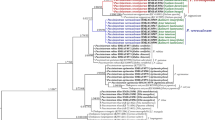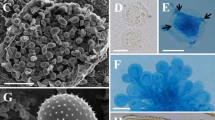Abstract
Based on a recent fieldwork in Panama, 25 species of rust fungi and several new hosts are reported for the first time from this country. Among the new records is one new species, Dicheirinia panamensis on Cojoba rufescens (Fabaceae). It differs from known species in the genus Dicheirinia by the presence of uredinia and telia without paraphyses, irregularly tuberculate urediniospores with two germ pores on the flattened sides, and tuberculate teliospores formed by three probasidial cells, subtended by a pedicel with three hyaline, apical cells.



Similar content being viewed by others
References
Arthur JC (1916) Uredinales of Puerto Rico based on collections by F.L. Stevens. Mycologia 8:16–33
Arthur JC (1918) New species of Uredineae-X. Bull Torrey Bot Club 45:141–156
Berndt R (2002) New species, reports and observations on rust fungi. Nova Hedwig 75:415–431
Berndt R (2004) A checklist of Costa Rican rust fungi. In: Agerer et al (eds) Frontiers in basidiomycete mycology. IHW-Verlag, Berlin, pp 185–236
Buriticá P (1999a) La familia Phakopsoraceae en el Neotrópico III, géneros: Batistopsora y Phakopsora. Rev Acad Colomb Cienc 23(87):271–305
Buriticá P (1999b) La familia Phakopsoraceae (Uredinales) en el neotrópico-IV. Géneros: Crossopsora, Cerotelium, Phragmidiella y Catenulopsora. Rev Acad Colomb Cienc 23(88):407–431
Buriticá P, Hennen JF (1980) Pucciniosireae (Uredinales, Pucciniaceae). Flora Neotrop 24:1–50
Buriticá P, Pardo-Cardona VM (1996) Flora Uredineana Colombiana. Rev Acad Colomb Cienc 20:183–236
Cummins GB (1935) The genus Dicheirinia. Mycologia 27:151–159
Cummins GB (1937) Descriptions of tropical rusts. Bull Torrey Bot Club 64:43–44
Cummins GB (1940) Descriptions of tropical rusts II. Bull Torrey Bot Club 67:67–75
Cummins GB (1960) Descriptions of tropical rusts IX. Bull Torrey Bot Club 87:31–45
Cummins GB (1978) Rust fungi on legumes and composites in North America. University of Arizona Press, Tucson
Cummins GB, Hiratsuka Y (2003) Illustrated genera of rust fungi, 3rd edn. American Phytopathological Society, St. Paul, Minnesota
Dietel P (1894) Die Gattung Ravenelia. Hedwigia 33:22–69 (+plates I–V)
Evans HC, Ellison CA (2005) The biology and taxonomy of rust fungi associated with the tropical vine Mikania micrantha, a major invasive weed in Asia. Mycologia 97:935–947
Farr DF, Rossman AY, Palm ME, McCray EB (2004) Fungal Databases, Systematic Botany and Mycology Laboratory, ARS, USDA. http://www.nt.ars-grin.gov/fungaldatabases. Cited 21 June 2004
Frederick RD, Snyder CL, Peterson GL, Bonde MR (2002) Polymerase chain reaction assays for the detection and discrimination of the soybean rust pathogens Phakopsora pachyrhizi and P. meibomiae. Phytopathology 92:217–227
Gallegos ML, Cummins GB (1981) Uredinales (Royas) de México, vol 2. Instituto Nacional de Investigaciones Agrícoles, Culiacán, Sinaloa, México
Gjaerum HB (1982) Rust fungi from Madeira. Bol Mus Munic Funchal 34:5–22
Gjaerum HB (1987) Rust fungi from the Canary Islands. Vieraea 17:51–71
Hennen JF, Cummins GB (1956) Uredinales parasitizing grasses of the tribe Chlorideae. Mycologia 48:126–162
Hennen JF, Cummins GB (1973) New taxa of Mexican rust fungi. Rep Tottori Mycol Inst 10:169–182
Hennen JF, McCain JW (1993) New species and records of Uredinales from the neotropics. Mycologia 85:970–986
Hennen JF, Hennen MM, Figueiredo MB (1982) Índice das ferrugens (Uredinales) do Brasil. Arch Inst Biol (São Paulo) 49(Suppl 1):1–201
Hennen JF, Sotão HMP, Hennen MMW (1998) The genus Diorchidium in the neotropics. Mycologia 90:1079–1086
Hennen JF, Figueiredo MB, Carvalho AA Jr, Hennen PG (2005) Catalogue of the species of plant rust fungi (Uredinales) of Brazil. http://www.jbrj.gov.br
Hernández JR, Hennen JF (2002) The genus Ravenelia in Argentina. Mycol Res 106:954–974
Hernández JR, Hennen JF (2003) Rust fungi causing galls, witches’ brooms and other abnormal plant growths in northwestern Argentina. Mycologia 95:728–755
Hernández JR, Palm ME, Castlebury LA (2002) Puccinia hemerocallidis, cause of daylily rust, a newly introduced disease in the Americas. Plant Dis 86:1194–1198
Hernández JR, Aime MC, Henckel T (2005a) Rust fungi of Guyana. Sydowia 57:122–189
Hernández JR, Eboh DO, Rossman AY (2005b) New reports of rust fungi (Uredinales) from Nigeria. Caldasia 27:213–221
Hernández JR, Hennen JF, Farr DF, McCray EB (n.d.) Ravenelia Online, Systematic Botany and Mycology Laboratory, ARS, USDA. http://www.nt.ars-grin.gov/taxadescriptions/keys/RaveneliaIndex.cfm
Huguenin B (1966) Micromycètes du pacifique sud (cinquième contribution). Urédinales de Nouvelle-Calédonie (I). Bull Trimest Soc Mycol Fr 82:248–273
Jackson HS (1922) New or noteworthy rusts on Carduaceae. Mycologia 14:104–120
Jackson HS (1926) The rusts of South America based on the Holway collections, I. Mycologia 18:139–162
Jackson HS (1931) The rusts of South America based on the Holway collections, IV. Mycologia 23:332–364
Jørstad I (1957) Uredinales from South America and tropical North America, chiefly collected by Swedish botanists. Ark Bot 3:443–490 (+plates I, II)
Jørstad I (1958) Uredinales of the Canary Islands. Skr Norske Vidensk-Akad. Oslo, Mat-Naturvidensk Kl 2:1–182
Jørstad I (1959) Uredinales from South America and tropical North America chiefly collected by Swedish botanists II. Ark Bot Sr 2(4):59–103
Kern FD (1938) Additions to the Uredinales of Venezuela. Mycologia 30:537–552
Kern FD, Chardón CE (1927) Notes on some rusts of Colombia. Mycologia 19:268–276
Kern FD, Thurston HW Jr (1954) Additional species of Uredinales from Colombia. Mycologia 46:354–357
Lenné JM (1990) World list of fungal diseases of tropical pasture species. Phytopathol Pap 31:1–162
McGuire JU Jr, Crandall BS (1967) Survey of insect pests and plant diseases of selected food crops of Mexico, Central America and Panama. Int Agric Dev Serv, ARS, USDA, AID
Ono Y, Hennen JF (1983) Taxonomy of the Chaconiaceous genera (Uredinales). Trans Mycol Soc Japan 24:369–402
Piepenbring M (2005) Sphaerophragmium pulchrum, a new species of rust fungi from Panama. Mycol Prog 4:161–166
Piepenbring M (2006) Checklist of fungi in Panama. Puente Biológico (Revista Científica de la Universidad Autónoma de Chiriquí, Panamá) 1:1–190 (+ 5 plates)
Piepenbring M, Caballero P, Arrocha C, Cáceres O (2002) Royas, carbones y otros hongos parásitos en plantas. Natura 10:26–36. http://www.redmeso.net/bv/natura/Meike.pdf. Cited 5 March 2005 (preliminary identifications)
Ramachar P, Cummins GB (1965) The species of Puccinia on the Paniceae. Mycopathol Mycol Appl 25:7–60
Spaulding P (1961) Foreign diseases of forest trees of the world. U.S.D.A. Agric Handb 197:1–361
Standley PC (1927) The flora of Barro Colorado Island, Panama. Smithson Misc Collect 78:1–32
Standley PC (1933) The flora of Barro Colorado Island, Panama. Harvard Univ. Arnold Arboretum Contr 5:16–21
Stevenson JA (1975) Fungi of Puerto Rico and the American Virgin Islands. Contr Reed Herb 23:1–743
Toler RW, Cuellar R, Ferrer JB (1959) Preliminary survey of plant diseases in the Republic of Panama, 1955–1958. Pl Dis Reporter 43:1201–1203
Urries MJ (1954) Dicheirinia canariensis nov. sp. An Jard Bot Madr 12:533–536
Urries MJ (1957) Hongos microscópicos de Canarias. El Museo Canario, p 140
Acknowledgment
We thank Laurene Levy (USDA/APHIS) for the molecular diagnosis of Phakopsora meibomiae. We also appreciate the collaboration by Ralph Mangelsdorff (University of Frankfurt) and Joe Kirkbride and John Wiersema (USDA/ARS) for identifying many host species, Manfred Ruppel for assistance with the SEM, and Roland Kirschner (University of Frankfurt) for help with the Latin description. Carl Williams and Omar Monteros (Universidad de Panama, Chiriquí) helped to visit fields of legume crops and Naira Camacho (Dirección Salud Vegetal del Ministerio de Desarrollo Agropecuario de Panama) assisted in obtaining permits. The trip by JRH was made possible by Doug Luster (USDA/ARS) as part of the survey for Phakopsora pachyrhizi in Central America and the Caribbean. The activities by Meike Piepenbring and Maritza Vega Rios were supported by the German Academic Exchange Service (DAAD), in the context of a university partnership between the University of Frankfurt and the Universidad Autónoma de Chiriquí, and by the German Research Foundation (DFG).
Author information
Authors and Affiliations
Corresponding author
Additional information
Taxonomical novelty: Dicheirinia panamensis J.R. Hern.,M. Piepenbr. and Vega Rios.
Rights and permissions
About this article
Cite this article
Hernández, J.R., Piepenbring, M. & Vega Rios, M.B. A new species, Dicheirinia panamensis, and new records of rust fungi from Panama. Mycol Progress 6, 81–91 (2007). https://doi.org/10.1007/s11557-007-0526-0
Received:
Revised:
Accepted:
Published:
Issue Date:
DOI: https://doi.org/10.1007/s11557-007-0526-0




